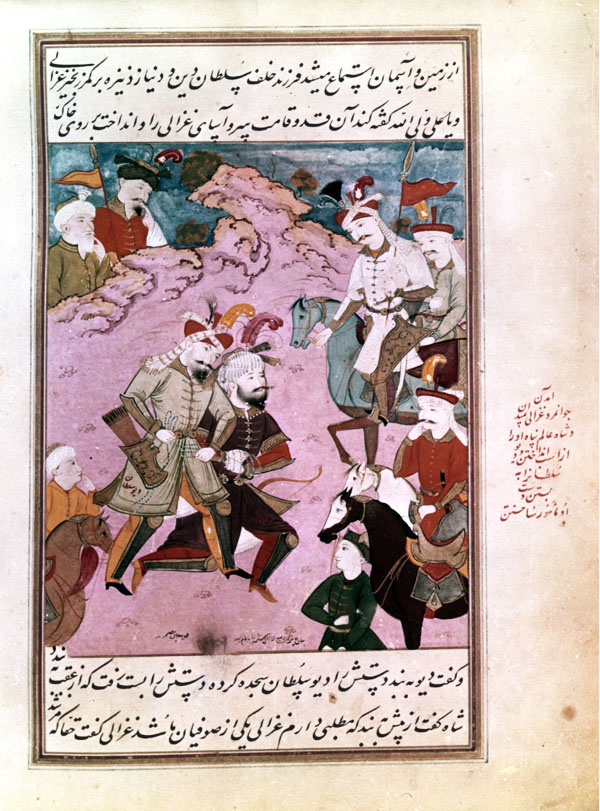Ḡazāli ʿArab Brought as a Prisoner Before Shah Esmāʿil
This event may be ficticious; the date would be subsequent to 1517 when the Ottomans overran the Mamluks; the place is the province of Diār Bakr. The ʿālām-ārā-ye šāh esmāʿil relates the following: Ḡazāli ʿArab was appointed governor of Damascus by the Mamluk ruler Sultan Ḡānisāy, and remained on as confidant to the Ottomans. Preoccupied with events in Europe, Sultan Selim entrusted Ḡazāli and Sultan Soleymān to secure the province of Diār Bakr. Ḡazāli’s first encounter with the qezelbāš was in a battle with Nur ʿAli Ḵalifa Rumlu, who valiantly died fighting with only 100 men, but impressed Ḡazāli with the courage of the qezelbāš. Hearing of this victory, the Ottoman sultan sent an additional 50,000 troops to Ḡazāli to secure the province. Meanwhile, Esmāʿil had already dispatched an army under the command of Div Solṭān Rumlu, who later acquired great powers under Shah Ṭahmāsp. Div Solṭān’s orders were not to engage the Turks until he, Esmāʿil, arrived. One by one, the Safavid commanders evacuated the garrisons in the province leaving only the empty fortresses for the Ottomans. In all Ḡazāli took over 42 empty garrisons before reaching the city of Diār Bakr and encountering Div Solṭān and the qezelbāš. Ghazåli wanted to do battle, but Div Solṭān explained that he was under orders not to fight until Esmāʿil arrived. Ḡazāli graciously postponed their encounter until Esmāʿil arrived, and the confrontation went ahead as planned. In the joust Ḡazāli unhorsed Div Solṭān with his lance. This angered Esmāʿil, who immediately rode forward to meet the Arab. In the ensuing encounter the shah unseated Ḡazāli, and ordered Div Solṭān to bring Ḡazāli prisoner before him. When Div Solṭān proceeded to bind Ḡazāli’s hands behind his back in the traditional manner for a prisoner, Esmāʿil interceded and instructed that his hands be bound in front because Ḡazāli would become one of his ṣufis. Sultan Soleymān and the Ottomans were allowed to depart, and the qezelbāš reoccupied the 42 vacated garrisons. Ḡazāli took the shiʿite vows and was awarded the governorship of four kingdoms in the south encompassing Khuzistan and Fars.
Ḡazāli is portrayed near the center of the picture, in a purple coat and white turban with feathers, his hands bound with cord, and being forced by Div Solṭān Rumlu to kneel before Esmāʿil, who stretches his arm in the direction of the captive. As in previous folios, the shah wears a white topcoat with gold trim and a red flat top qezelbāš headgear. In addition to Div Solṭān, two other qezelbāš accompany the shah, one in off-white clothing and partly obscured, the other in vermillion on a white horse in the right foreground. A brown horse, apparently belonging to Ḡazāli, is held by a groom in the lower left, and a corresponding black horse and groom belonging to Div Solṭān in the lower right. Two bearded individuals, part of Ḡazāli’s entourage, peer at the event from the ridge in the upper left. The backdrop is simply done: a pinkish-mauve hillside rises to a craggy rock ridge near the top, some sparse suggestions of foliage, and at the top a variegated blue sky.
Location: Reza Abbasi Museum, Tehran, No.77.1.7, folio 332v
Painting: 16.0 x 13.2 cm. Dimensions from Mahboubian catalog. A marginal inscription in red describes the event. Inscriptions, also in red, appear on two figures, identifying them as div solṭān and ǧazāli. A black inscription appears at the bottom of the painting, the first portion of which, in a handwriting that might well be Moʿin’s, states betāriḵ-e nima(?) rabiʿ al-avval sana 1010 ba etmam rasid...(completed in the middle of Rabiʿ I of the year 1010/September 1601...). Stylistically this date is impossible, and may have been intended for 1100/January 1689. The end of the inscription, which may have include the artist’s signature, is smeared and illegible; above the smear is written, in a different hand, doubtlessly an attribution, amol-e moʿin-e moṣavver.
Painting references: Mahboubian_1972, #923 folio 332v (not ill.).
Text references: See Muntaẓer-Ṣāḥeb_1970, pp.579-80 for this event in the History of Shah Esmāʿil.
Robert Eng
Last Updated: Dec. 21, 2011 | Previous update: Dec. 16, 2010 | Originally published: April 4, 2002
